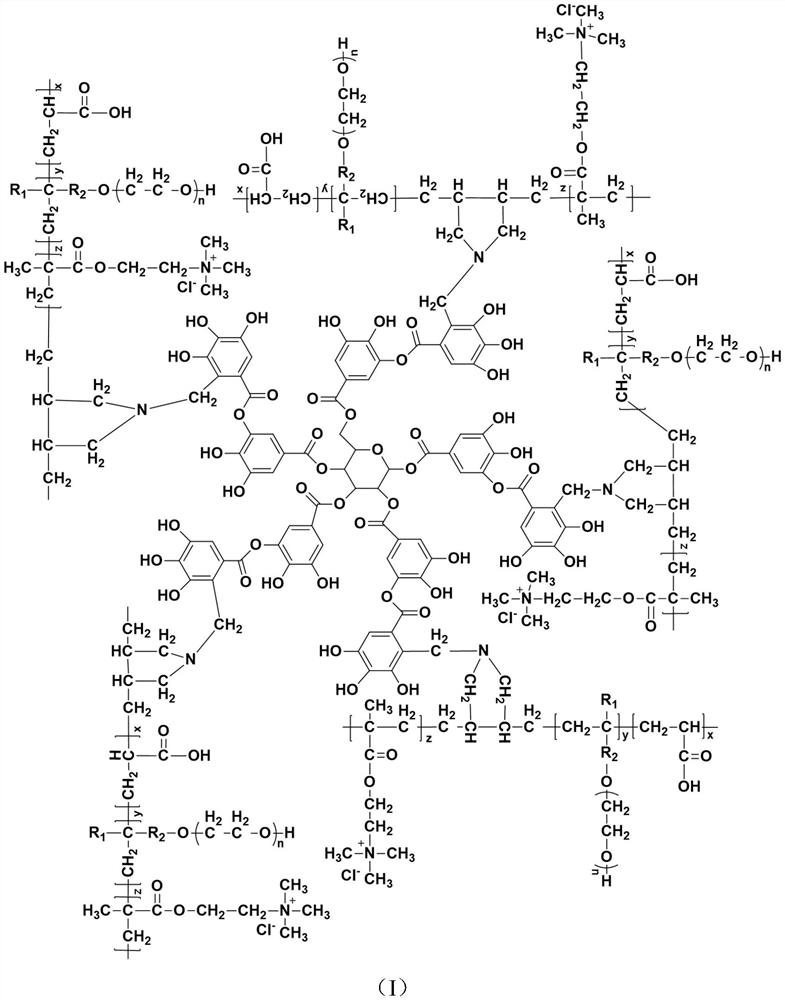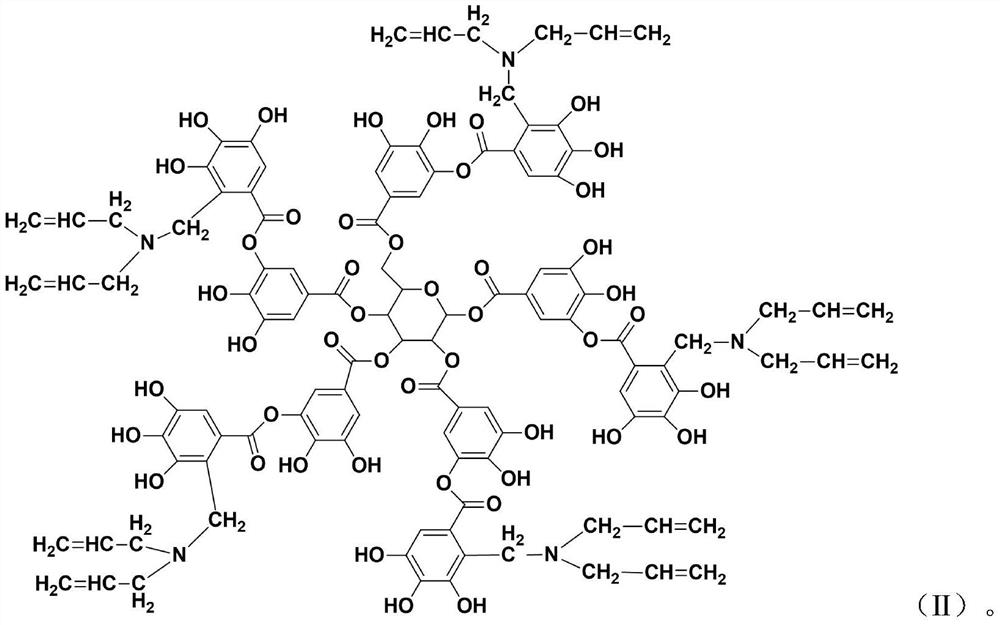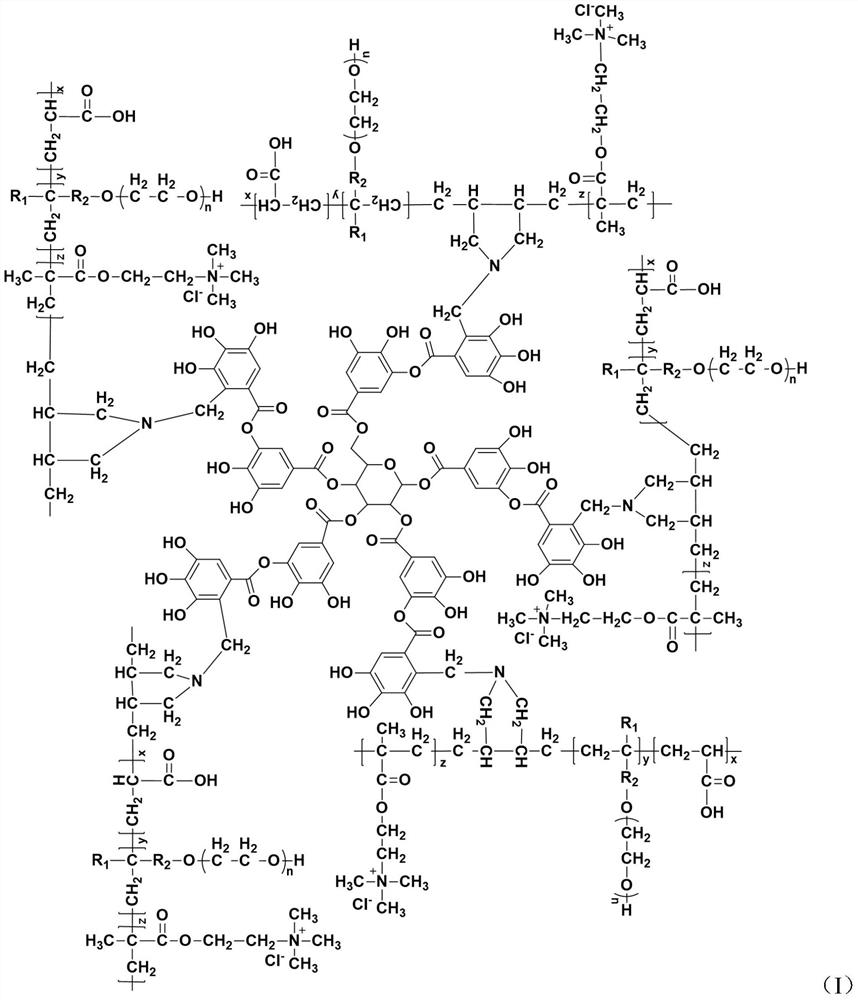Anti-mud tannic acid-based star-shaped polycarboxylate superplasticizer and preparation method thereof
A tannic acid-based, anti-mud technology, applied in the field of building material admixtures, can solve the problems of insignificant anti-mud effect, single molecular structure, complex preparation process, etc., and achieve good dispersion and dispersion retention, surface The effect of rich functional groups and small hydrodynamic volume
- Summary
- Abstract
- Description
- Claims
- Application Information
AI Technical Summary
Problems solved by technology
Method used
Image
Examples
Embodiment 1
[0021] A preparation method of an anti-mud type tannic acid-based star polycarboxylate water reducer, comprising the following steps:
[0022] Add 250g of water and 300g of polyether macromonomer APEG to a 1000mL four-neck round-bottomed flask equipped with a thermometer, an electric stirrer, a constant temperature electric heating mantle, and a peristaltic pump. 12g of tannic acid functional monomer, stirred and raised to 58°C, dissolved evenly, directly added a mixed solution of 3.9g of ammonium persulfate and 16g of water and stirred for 10 minutes to fully dissolve. Add dropwise the mixed aqueous solution that is made up of 45g of acrylic acid, 7g of methacryloyloxyethyltrimethylammonium chloride, 76g of water and the mixed solution of ascorbic acid 0.80g, mercaptopropionic acid 1.6g, and water 90g in 3 hours, Keep the temperature between 57-60°C; continue to react for 2 hours after the dropwise addition is completed, then cool down to 30-35°C, add 30% sodium hydroxide sol...
Embodiment 2
[0025] A preparation method of an anti-mud type tannic acid-based star polycarboxylate water reducer, comprising the following steps:
[0026] Add 250g of water and 300g of polyether macromonomer HPEG to a 1000mL four-neck round-bottomed flask equipped with a thermometer, an electric stirrer, a constant temperature electric heating mantle, and a peristaltic pump. 12g of tannic acid functional monomer, stirred and raised to 58°C, dissolved evenly, directly added a mixed solution of 3.9g of ammonium persulfate and 16g of water and stirred for 10 minutes to fully dissolve. Add dropwise the mixed aqueous solution that is made up of 45g of acrylic acid, 7g of methacryloyloxyethyltrimethylammonium chloride, 76g of water and the mixed solution of ascorbic acid 0.80g, mercaptopropionic acid 1.6g, and water 90g in 3 hours, Keep the temperature between 57-60°C; continue to react for 2 hours after the dropwise addition is completed, then cool down to 30-35°C, add 30% sodium hydroxide sol...
Embodiment 3
[0029] A preparation method of an anti-mud type tannic acid-based star polycarboxylate water reducer, comprising the following steps:
[0030] Add 250g of water and 300g of polyether macromonomer TPEG to a 1000mL four-necked round-bottomed flask equipped with a thermometer, an electric stirrer, a constant temperature electric heating mantle, and a peristaltic pump. 12g of tannic acid functional monomer, stirred and raised to 58°C, dissolved evenly, directly added a mixed solution of 3.9g of ammonium persulfate and 16g of water and stirred for 10 minutes to fully dissolve. Add dropwise the mixed aqueous solution that is made up of 45g of acrylic acid, 7g of methacryloyloxyethyltrimethylammonium chloride, 76g of water and the mixed solution of ascorbic acid 0.80g, mercaptopropionic acid 1.6g, and water 90g in 3 hours, Keep the temperature between 57-60°C; continue to react for 2 hours after the dropwise addition is completed, then cool down to 30-35°C, add 30% sodium hydroxide s...
PUM
 Login to View More
Login to View More Abstract
Description
Claims
Application Information
 Login to View More
Login to View More - R&D
- Intellectual Property
- Life Sciences
- Materials
- Tech Scout
- Unparalleled Data Quality
- Higher Quality Content
- 60% Fewer Hallucinations
Browse by: Latest US Patents, China's latest patents, Technical Efficacy Thesaurus, Application Domain, Technology Topic, Popular Technical Reports.
© 2025 PatSnap. All rights reserved.Legal|Privacy policy|Modern Slavery Act Transparency Statement|Sitemap|About US| Contact US: help@patsnap.com



